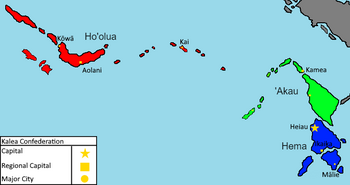Kalea Confederation
Kalea Confederation Aupuni Hui Kalea | |
|---|---|
|
Flag | |
| Motto: “He aliʻi ka ʻāina; he kauwā ke kanaka.” (Hawaiian) “The land is the chief; man is its servant.” | |
| Anthem: TBD | |
 | |
| Capital and largest city | Heiau |
| Official languages | Kalean (Hawaiian) |
| Recognised national languages | Kalean (Hawaiian) |
| Recognised regional languages | Niʻihau (Kalean (Hawaiian) dialect) |
| Ethnic groups | Kalean (96%), Ni'ihau (3%), Other (1%) |
| Religion | Buddhism (52%), Taoism (31%), Atheist (10%), Ni'ihau folk religion (5%), Other (2%) |
| Demonym(s) | Kalean, Niʻihau |
| Government | Libertarian socialist federated semi-direct democracy |
• Haoa (traditional title); Co-President (official title) | Alana Kalama |
• Haoa (traditional title); Co-President (official title) | Pika Akamai |
• Haoa (traditional title); Co-Chair (official title) | Eleu Kamea |
• Haoa (traditional title); Co-Chair (official title) | Na'au Kealoha |
| Legislature | Kalean Democratic Council |
| Area | |
• Total | 282,383 km2 (109,029 sq mi) |
| Population | |
• 2020 estimate | 7.46 million |
| Currency | Kalean Dala |
| Date format | DD/MM/YY |
| Driving side | right |
| Calling code | +900 |
| Internet TLD | .kal |
The Kalea Confederation is a sovereign nation comprised of the Kalea island chain in the geographic region West of the continent of Ausiana. It is situated in the eastern portion of the Toyana Ocean, just south of the Alutia Sea and just west of the Sancheon Gulf. The climate consists of mostly subtropical forests. Its government functions as a libertarian socialist federated semi-direct democracy currently administered by a coalition of leftist parties. It consists of self-governing sub-regions in the provinces of Ho'olua, 'Akau and Hema. It has a population of 7.46 million inhabitants. It has a total area of 109,029 sq. mi (282,383 sq. km). Its capital and largest city is Heiau.
Etymology
The word "Kalea" means “happiness” and “joy” in Kalean. The Confederation was named after the man most Kaleans consider as the "Father of the Confederation" and the "First Haoa," Kalea Apekalmoa. As well as naming Kalea after him, the most commonly spoken language at the time, the language now known as Kalean today, and the demonym of the people of Kalea, were named in honor of him.
History
Geography
The landscape of Kalea is dominated by subtropical forests. The features of Kalea's climate include mild temperatures throughout the year, significant differences in rainfall within short distances, and infrequent severe storms. Monsoons are a frequent occurrence during rainfall in Kalea.
Climate
Environment
Politics and government
The political system of the region is based on its adopted constitution, officially titled "Charter of the Three Provinces". It provides that all residents of the region shall enjoy fundamental rights such as gender equality and freedom of religion. It also provides for property rights. The region's system of community government has direct democratic aspirations.
==Executive branch
Political parties
The Kalean Democratic Council is currently dominated by a coalition of left-wing parties, the largest of which are the Democratic Confederalist Party, Syndicalist Party, and Buddhist Socialist Party. The Opposition is comprised of a coalition of minor parties, most of which are center-left to center-right.
Military
Foreign relations
Economy
The history of Kalea's economy can be traced through a succession of dominant industries: sandalwood, whaling, sugarcane, pineapple, the military, tourism and education. The majority of Kalean exports include food and clothing. The country's food exports include coffee, macadamia nuts, pineapple, livestock, sugarcane and honey.
Energy
Industry
Infrastructure
Transport
Demographics
The population of Kalea as of 2020 is estimated to be around 2020 7.46 million. An overwhelming majority of around 96% of the population is homogeneuosly Native Kalean, while the remaining 4% is divided between around 3% being part of the Ni'ihau tribe and 1% other ethnicities.
Education
Religion
Religion in Kalea is dominated by over half (52%) of the population practicing Buddhism, while just under a third (31%) of the population practices Taosim. Buddhism and Taosim form a close relationship in Kalea with either of the religions influencing the other. The remaining population is either Atheist (10%), or adheres to Ni'ihau folk religion (5%) or another religion (2%). The Ni'ihau folk religion is rarely seen outside of the Ni'ihau community.
